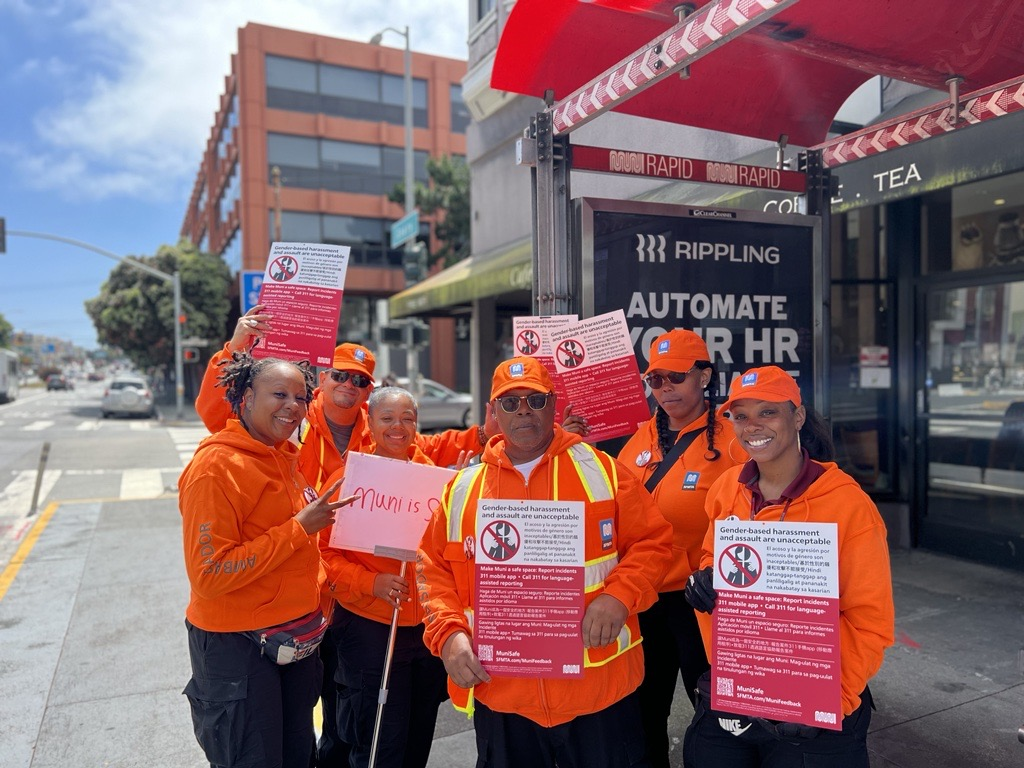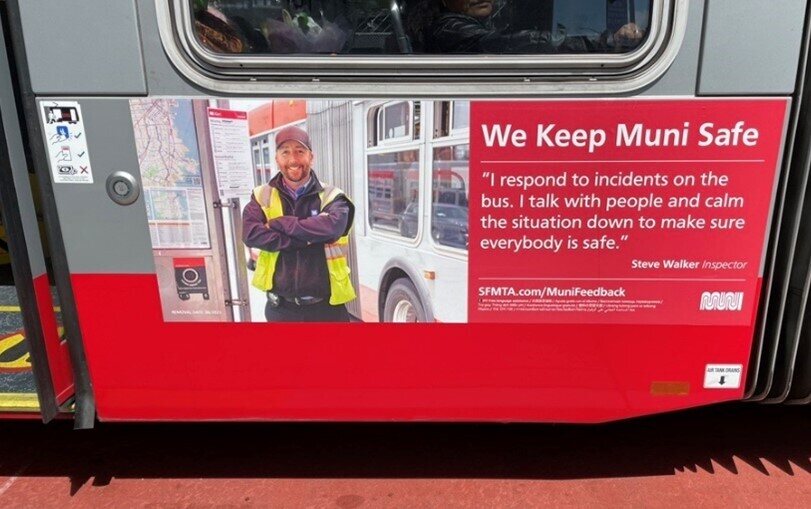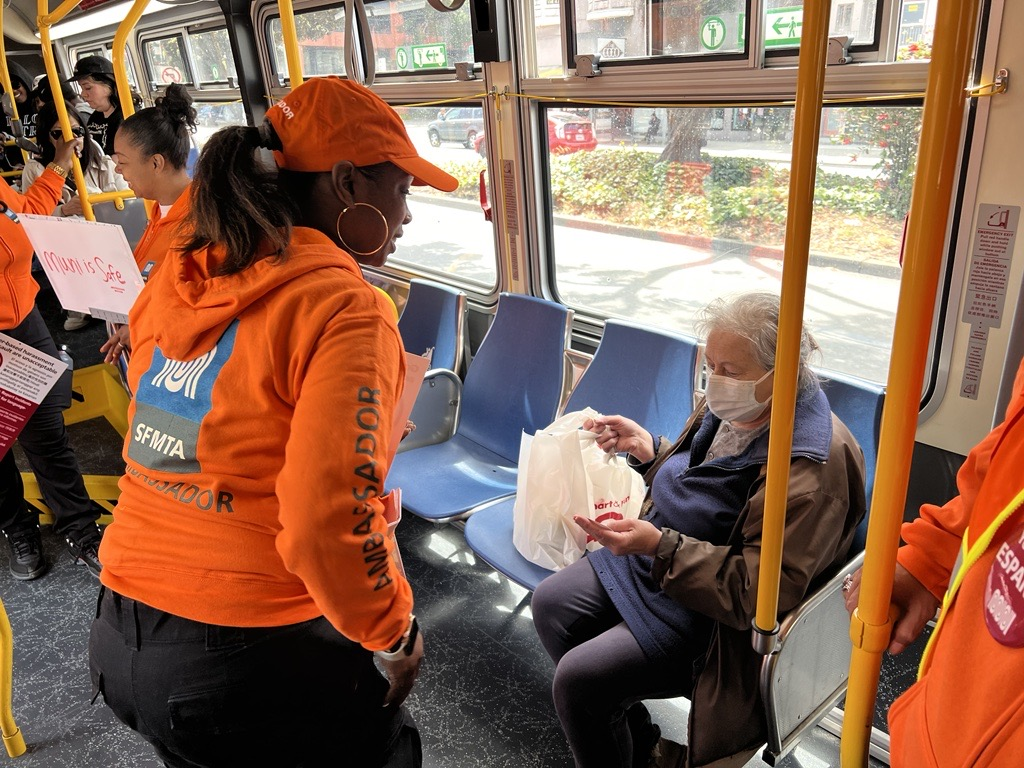By Janice Tan
 During our MuniSafe Day Out last June, SFMTA staff shared how to report harassment.
During our MuniSafe Day Out last June, SFMTA staff shared how to report harassment.
To make our system safer for everyone, we launched MuniSafe and the Safety Equity Initiative in 2022. These programs strengthen our work to prevent and address harassment across Muni vehicles, stops and stations. They also encourage people to report any issues.
We're excited to share what we’ve been doing to create safer conditions. We’ll cover our everyday efforts in de-escalation and enforcement. We’ll also share how you can take steps today to prevent and report harassment. Lastly, we’ll highlight what's next for MuniSafe.
De-escalation: hiring more ambassadors to help customers and reduce conflicts
There are now more staff across our system to provide support. We've hired more transit ambassadors to join our 3,150 employees who interact with customers. Our ambassadors can help stop or calm down conflicts before they get worse.

Transit ambassadors and other staff are here to help support you in difficult situations.
Enforcement: partnering with city agencies and capturing video to aid investigations
We’re also working to make your trips safer through enforcement. We continue to partner closely with the San Francisco Police Department and the District Attorney’s Office to make sure crimes on Muni are investigated and prosecuted.
Each Muni bus and train has at least 11 cameras that are always recording video and sound. This helps deter crime. It also helps us investigate any incidents that occur, especially when we get reports of serious issues. Our efforts are working: overall crime on Muni is down 48 percent from 2018.
Education and outreach: sharing resources to support prevention and reporting
You can access a range of resources to help prevent and report harassment on Muni. You’ll find them on our MuniSafe program webpage (SFMTA.com/MuniSafe).
We appreciate your efforts to report incidents. The more we know about safety concerns on Muni, the better we can address them. Your reports help us improve our safety responses and staffing. That’s why we’re working to raise awareness about MuniSafe across all our channels.
Our message is simple: We don’t tolerate harassment and you have multiple options to report it.
We’ve shared this across:
-
35,000 text messages
-
30,000 wallet cards and tear sheets
-
16,000 emails
We also put up multilingual signs at 1,500 Muni stops and 15 Muni Metro stations.
 An SFMTA staffer teaches a rider how to report harassment and other issues.
An SFMTA staffer teaches a rider how to report harassment and other issues.
Our teams helped businesses promote the message with posters for their front windows. We also raised awareness on our busiest lines through “MuniSafe Day Out.” Last June, about 100 SFMTA staff put up posters and handed out cards about MuniSafe along Muni's seven busiest routes.
What’s next: using data to improve safety
Over the past year, we've also been working hard to gather more accurate information about safety and security problems on Muni.
Our annual community and rider surveys now ask about experiences with harassment on Muni to give us a much clearer picture of safety concerns and how we can address them. Last year, we partnered with UCLA’s Institute of Transportation Studies for an in-depth survey about harassment experiences, and we’re moving forward with data-driven solutions.
A new state law requires the ten largest transit agencies in California to collect voluntary survey data about harassment. The goal: identify root causes to improve safety. Our work has put us ahead of the game. This year we’ll conduct another in-depth survey to measure our progress, learn from other agencies across the state and continue to shape our work to keep everyone safe on Muni.
Using this data and other learnings, we’re now drafting a Safety Equity Action Plan. We’re considering various steps to continue making Muni safer. These include:
-
Improving bus stop lighting
-
Working with community partners to address the needs and experiences of our diverse riders
-
Developing new educational campaigns to help people act and get assistance
-
Exploring additional staffing needs
-
Improving incident reporting tools and mechanisms
-
Improving and expanding our data collection
You can learn more about MuniSafe on our MuniSafe program webpage (SFMTA.com/MuniSafe).
Published May 03, 2024 at 10:01PM
https://ift.tt/fErImAR
Comments
Post a Comment